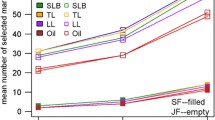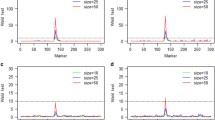Abstract
Detection of QTL in multiple segregating families possesses many advantages over the classical QTL mapping in biparental populations. It has thus become increasingly popular, and different biometrical approaches are available to analyze such data sets. We empirically compared an approach based on linkage mapping methodology with an association mapping approach. To this end, we used a large population of 788 elite maize lines derived from six biparental families genotyped with 857 SNP markers. In addition, we constructed genetic maps with reduced marker densities to assess the dependency of the performance of both mapping approaches on the marker density. We used cross-validation and resample model averaging and found that while association mapping performed better under high marker densities, this was reversed under low marker densities. In addition to main effect QTL, we also detected epistatic interactions. Our results suggest that both approaches will profit from a further increase in marker density and that a cross-validation should be applied irrespective of the biometrical approach.







Similar content being viewed by others
References
Blanc G, Charcosset A, Mangin B, Gallais A, Moreau L (2006) Connected populations for detecting quantitative trait loci and testing for epistasis: an application in maize. Theor Appl Genet 113:206–224
Broman KW, Sen S (2009) A guide to QTL mapping with R/qtl. Springer Science + Business Media, LLC
Buckler ES, Holland JB, Bradbury PJ, Acharya CB, Brown PJ et al (2009) The genetic architecture of maize flowering time. Science 325:714–718
Carlborg Ö, Haley CS (2004) Epistasis: too often neglected in complex trait studies? Nat Rev Genet 5:618–625
Churchill GA, Doerge RW (1994) Empirical threshold values for quantitative trait mapping. Genetics 138:963–971
Coles ND, McMullen MD, Balint-Kurti PJ, Pratt RC, Holland JB (2010) Genetic control of photoperiod sensitivity in maize revealed by joint multiple population analysis. Genetics 184:799–822
Flint-Garcia SA, Thornsberry JM, Buckler ES (2003) Structure of linkage disequilibrium in plants. Ann Rev Plant Biol 54:357–374
Hill WG, Robertson A (1968) Linkage disequilibrium in finite populations. Theor Appl Genet 38:226–231
Holland JB (2007) Genetic architecture of complex traits in plants. Curr Opin Plant Biol 10:156–161
Holland JB, Portyanko VA, Hoffmann DL, Lee M (2002) Genomic regions controlling vernalization and photoperiod responses in oat. Theor Appl Genet 105:113–126
Holm S (1979) A simple sequentially rejective multiple test procedure. Scand J Stat 6:65–70
Jansen RC, Stam P (1994) High resolution of quantitative traits into multiple loci via interval mapping. Genetics 136:1447–1455
Liu W, Gowda M, Steinhoff J, Maurer HP, Würschum T et al (2011) Association mapping in an elite maize breeding population. Theor Appl Genet 123:847–858
Liu W, Maurer HP, Reif JC, Melchinger AE, Utz HF et al (2012) Optimum design of family structure and allocation of resources in association mapping with lines from multiple crosses (in review)
Lu Y, Zhang S, Shah T, Xie C, Hao Z, Li X et al (2010) Joint linkage–linkage disequilibrium mapping is a powerful approach to detecting quantitative trait loci underlying drought tolerance in maize. Proc Natl Acad Sci USA 107:19585–19590
Maurer HP, Melchinger AE, Frisch M (2008) Population genetic simulation and data analysis with Plabsoft. Euphytica 161:133–139
Myles S, Peiffer J, Brown PJ, Ersoz ES, Zhang Z et al (2009) Association mapping: critical considerations shift from genotyping to experimental design. Plant Cell 21:2194–2202
Piepho HP (2000) Optimal marker density for interval mapping in a backcross population. Heredity 84:437–440
Reif JC, Liu W, Gowda M, Maurer HP, Möhring J et al (2010) Genetic basis of agronomically important traits in sugar beet (Beta vulgaris L.) Investigated with joint linkage association mapping. Theor Appl Genet 8:1489–1495
Reif JC, Gowda M, Maurer HP, Longin CFH, Korzun V et al (2011a) Association mapping for quality traits in soft winter wheat. Theor Appl Genet 122:961–970
Reif JC, Maurer HP, Korzun V, Ebmeyer E, Miedaner T et al (2011b) Mapping QTLs with main and epistatic effects underlying grain yield and heading time in soft winter wheat. Theor Appl Genet 123:283–292
SAS Institute Inc (2008) SAS user’s guide, version 9.2. SAS Institute: Cary, NC, USA
Schön CC, Utz HF, Groh S, Truberg B, Openshaw S, Melchinger AE (2004) Quantitative trait locus mapping based on resampling in a vast maize testcross experiment and its relevance to quantitative genetics for complex traits. Genetics 167:485–498
Schwarz G (1978) Estimating the dimension of a model. Ann Stat 6:461–464
Sillanpää MJ (2011) Overview of techniques to account for confounding due to population stratification and cryptic relatedness in genomic data association analyses. Heredity 106:511–519
Steinhoff J, Liu W, Maurer HP, Würschum T, Longin FH et al (2011) Multiple-line cross QTL-mapping in European elite maize. Crop Sci 51:2505–2516
Utz HF, Melchinger AE, Schön CC (2000) Bias and sampling error of the estimated proportion of genotypic variance explained by quantitative trait loci determined from experimental data in maize using cross validation and validation with independent samples. Genetics 154:1839–1849
Valdar W, Holmes CC, Mott R, Flint J (2009) Mapping in structured populations by resample model averaging. Genetics 182:1263–1277
Van Inghelandt D, Reif JC, Dhillon BS, Flament P, Melchinger AE (2011) Extent and genome-wide distribution of linkage disequilibrium in commercial maize germplasm. Theor Appl Genet 123:11–20
Verhoeven KJF, Jannink JL, Mclntyre LM (2006) Using mating designs to uncover QTL and the genetic architecture of complex traits. Heredity 96:139–149
Weir BS (1996) Genetic data analysis II, 2nd edn. Sinauer Associates, Sunderland
Whitt SR, Wilson LM, Tenaillon MD, Gaut BS, Buckler ES (2002) Genetic diversity and selection in the maize starch pathway. Proc Natl Acad Sci 99:12959–12962
Würschum T (2012) Mapping QTL for agronomic traits in breeding populations. Theor Appl Genet. doi:10.1007/s00122-012-1887-6
Würschum T, Maurer HP, Kraft T, Janssen G, Nilsson C et al (2011a) Genome-wide association mapping of agronomic traits in sugar beet. Theor Appl Genet 123:1121–1131
Würschum T, Maurer HP, Schulz B, Möhring J, Reif JC (2011b) Genome-wide association mapping reveals epistasis and genetic interaction networks in sugar beet. Theor Appl Genet 123:109–118
Würschum T, Liu W, Gowda M, Maurer HP, Fischer S et al (2012a) Comparison of biometrical models for joint linkage association mapping. Heredity 108:332–340
Würschum T, Liu W, Maurer HP, Abel S, Reif JC (2012b) Dissecting the genetic architecture of agronomic traits in multiple segregating populations in rapeseed (Brassica napus L.). Theor Appl Genet 124:153–161
Yu J, Holland JB, McMullen MD, Buckler ES (2008) Genetic design and statistical power of nested association mapping in maize. Genetics 178:539–551
Zeng ZB (1994) Precision mapping of quantitative trait loci. Genetics 136:1457–1468
Acknowledgments
This research was conducted within the Biometric and Bioinformatic Tools for Genomics based Plant Breeding Project of the GABI-FUTURE initiative.
Author information
Authors and Affiliations
Corresponding author
Additional information
Communicated by M. Sillanpaa.
Rights and permissions
About this article
Cite this article
Liu, W., Reif, J.C., Ranc, N. et al. Comparison of biometrical approaches for QTL detection in multiple segregating families. Theor Appl Genet 125, 987–998 (2012). https://doi.org/10.1007/s00122-012-1889-4
Received:
Accepted:
Published:
Issue Date:
DOI: https://doi.org/10.1007/s00122-012-1889-4




